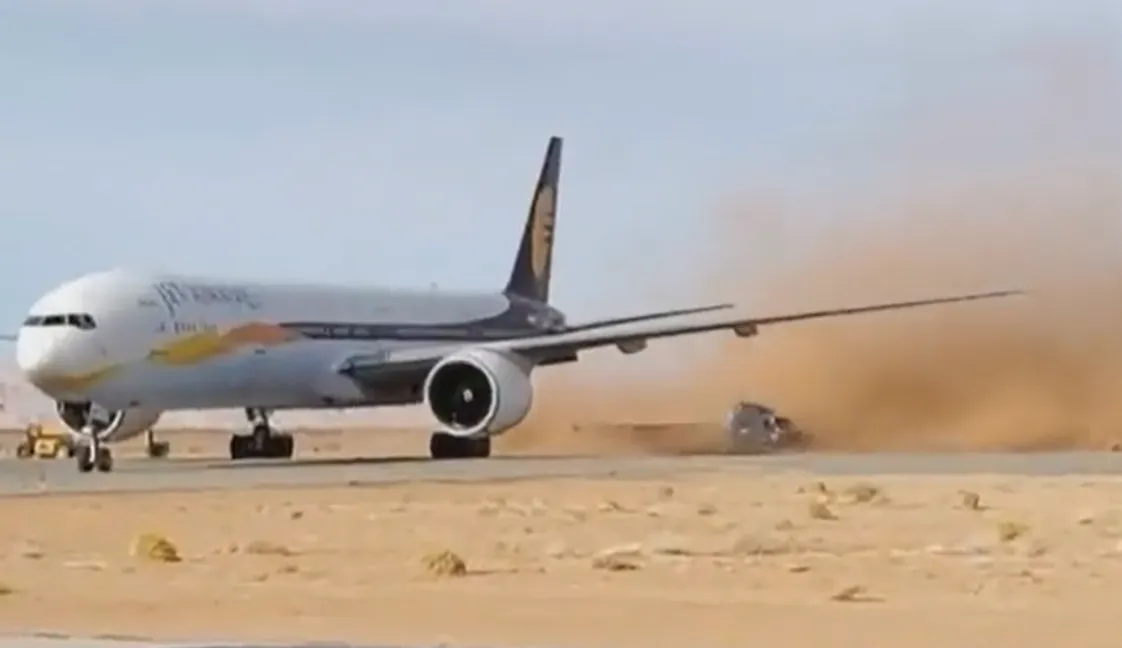
Boeing 777 Blows Semi-Trailer Truck Over
Nov 09, 2022

A Boeing 777 experienced a dramatic incident when its powerful jet blast unexpectedly blew over a semi-trailer truck parked nearby. The event occurred during takeoff at a busy airport, where the aircraft's engines generated significant thrust, creating a strong gust of wind. Witnesses reported seeing the truck topple onto its side, causing momentary chaos on the ground. Fortunately, no injuries were reported, as the truck was unoccupied at the time. Airport authorities quickly assessed the situation to ensure the safety of operations while investigating the incident to prevent future occurrences involving ground vehicles near active runways.
The Boeing 777 is renowned for its impressive engineering and capabilities, but it also has the potential to create significant disturbances when in motion. This article delves into an incident where a Boeing 777 blew over a semi-trailer truck, examining the physics behind such an event and its implications for aviation safety and ground operations.
Understanding the Incident
On a day when weather conditions were less than ideal, a Boeing 777 took off, generating strong winds that inadvertently affected nearby vehicles, including a semi-trailer truck. The incident highlights the power of large aircraft and the need for stringent safety measures on the ground.
Physics of the Boeing 777's Wake Turbulence
Wake turbulence is a significant factor in understanding how large aircraft like the Boeing 777 can impact their surroundings. When the aircraft takes off or lands, it displaces a massive amount of air, creating vortices that can extend several hundred feet behind the airplane. These vortices can be powerful enough to disrupt the stability of vehicles in proximity to the flight path.
Key Factors Contributing to the Incident
Several factors contributed to the incident involving the Boeing 777 and the semi-trailer truck:
- Aircraft Size and Weight: The Boeing 777 is one of the largest commercial aircraft, weighing up to 775,000 pounds at maximum takeoff weight. This immense weight generates significant lift and turbulence.
- Wind Conditions: High winds can exacerbate the effect of wake turbulence, making it more likely for vehicles to be affected. In this case, the combination of takeoff thrust and crosswinds played a crucial role.
- Proximity to the Runway: The semi-trailer truck was likely positioned too close to the runway during takeoff, increasing the risk of being impacted by the turbulence generated by the Boeing 777.
Implications for Aviation Safety
The incident involving the Boeing 777 and the semi-trailer truck raises important questions about aviation safety and ground operations. Here are some key implications:
- Ground Operations Training: Ground personnel must be trained to understand the effects of wake turbulence and to maintain safe distances from active runways.
- Regulatory Measures: Regulatory bodies may need to review and update guidelines regarding the safe distances required for vehicles operating near airports.
- Public Awareness: Increased public awareness of the potential hazards associated with large aircraft can help mitigate risks and enhance safety protocols.
Preventive Measures and Recommendations
To avoid similar incidents in the future, several preventive measures can be recommended:
| Measure | Description |
|---|---|
| Enhanced Signage: | Installing clear signage near airports to inform drivers of potential hazards related to aircraft operations. |
| Distance Regulations: | Implementing regulations that dictate safe distance requirements for vehicles near runways and taxiways. |
| Awareness Campaigns: | Conducting campaigns to educate the public about the effects of wake turbulence and safe practices around airports. |
Conclusion
The incident involving the Boeing 777 blowing over a semi-trailer truck serves as a reminder of the powerful forces at play in aviation. Understanding the dynamics of wake turbulence and implementing effective safety measures are crucial in preventing similar occurrences in the future. As aviation continues to grow, so too must our commitment to safety on the ground.
For those involved in ground operations, staying informed and adhering to safety guidelines is essential to ensure the safety of both aviation personnel and the public. By understanding the potential risks and taking proactive measures, we can continue to enjoy the benefits of modern aviation while minimizing hazards associated with it.
Related Articles

Explore Thailand: The Best Islands to Visit for Paradise, Adventure, and Relaxation

The Ultimate Guide to the Best Islands in Thailand for Your Next Getaway

Do babies need passports? How to get a passport for a newborn

How to get a U.S. passport fast: here’s how to expedite the process

What is Mobile Passport Control: 5 reasons why you should use it

SENTRI vs. Global Entry: A detailed guide

Do you need a passport to go to the Bahamas? Let’s find out

Do you need a passport to go to Mexico? A detailed guide

Do you need a passport to go to Canada? We got the answer

Do You Need a Passport for a Cruise: An Essential Travel Guide

Booster Seat Requirements: All the Rules to Follow in Your Rental Car

What Are the World’s Most Powerful Passports, and How Does Yours Rank?

How to Take a Passport Photo at Home: A Helpful Guide

You've got to have heart! Southwest's new livery

Your opinion: Should water be free on low cost carriers?

Young women bolder than guys as solo travellers
